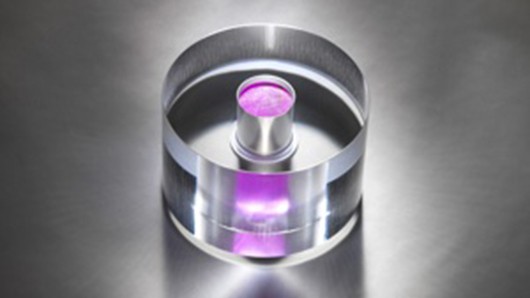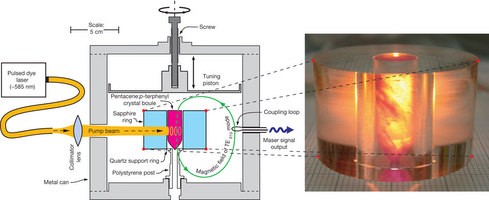Room-temperature solid state maser may be the laser of tomorrow
By David Szondy
August 17, 2012

The core of the new solid state maser (Photo: National Physics Laboratory)
Everyone has heard of lasers, but hardly anyone outside of a physics lab or a science fiction novel has heard of a maser. Despite the fact that it was the precursor of the laser, the maser has been something of a technological backwater because masers are difficult to build and expensive to operate. That, however, may be changing. In the August 16 issue of Nature, a team of scientists from Britainís National Physics Laboratory and Imperial College, London led by Dr. Mark Oxborrow report that they have created the first solid state maser that operates at room temperature, paving the way toward the widespread practical application of the technology.
Maser is an acronym that stands for Microwave Amplification by Stimulated Emission of Radiation. Essentially, itís the same as a laser, but where a laser generates an intense, coherent beam of light, a maser generates an intense, coherent beam of microwaves. Masers were invented in the 1950s and laid the groundwork for invention of the laser in the early 1960s, but the two technologies soon took very different paths.
The first lasers required exotic materials to work. The original laser used a ruby crystal and later lasers relied on gases like helium and neon. However, scientists soon discovered other materials that could generate laser beams and it wasnít long before inexpensive solid state lasers were on the market. The result is that today lasers are used in everything from telecommunications to weapon systems and it isnít unusual for a household to have half a dozen lasers lurking about the place in various bits of technology.
Masers, on the other hand, remained inhabitants of the laboratory. Thatís because masers remained extremely expensive, temperamental pieces of equipment. They either needed special vacuum chambers to work or temperatures close to absolute zero (-273.15 C, -459.67 F). In either case, they often needed intense magnetic fields, too. With these difficulties, itíís small wonder that masers remained confined to atomic clocks and astrophysical research.
What Oxborrow and the NPL/Imperial team did was to change all this by developing a new maser that is solid state, operates at room temperature and doesnít require a magnetic field. Their breakthrough was to replace the hard, inorganic maser crystal with an organic mixed-molecular crystal, p-terphenyl doped with pentacene. The pentacene, which makes the crystal look pink, is photo-excited by yellow light. This allowed the team to excite the crystal by pumping energy into it with pulses of light. This, in turn, set off a series of reactions that made the crystal act like an oscillator and generate a maser beam.
The implications of this new technology are hard to imagine. Fifty years ago, the laser was dubbed the solution in search of a problem. Now that mantle has passed to the maser.
"When lasers were invented no one quite knew exactly how they would be used and yet, the technology flourished to the point that lasers have now become ubiquitous in our everyday lives, says Dr. Oxborrow. "We've still got a long way to go before the maser reaches that level, but our breakthrough does mean that this technology can literally come out of the cold and start becoming more useful."
Among the possible applications for the maser are new medical scanning devices, explosives detectors, quantum computer components and even radio telescopes for detecting life on other planets. However, there are still hurdles to overcome, such as getting the maser to operate continually instead of in pulses and making it operate over a range of frequencies while using less power. Once that happens, it may not be too long before youíre wondering if you really need that maser pointer you just bought.
The NPL video below describes the maser.
Sources: National Physics Laboratory, Nature

